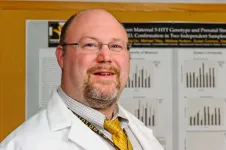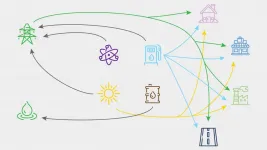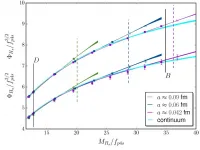(Press-News.org) A new view of the region closest to the supermassive black hole at the center of the galaxy Messier 87 (M87) has shown important details of the magnetic fields close to the black hole and hints about how powerful jets of material can originate in that region.
A worldwide team of astronomers using the Event Horizon Telescope, a collection of eight telescopes, including the Atacama Large Millimeter/submillimeter Array (ALMA) in Chile, measured a signature of magnetic fields -- called polarization -- around the black hole. Polarization is the orientation of the electric fields in light and radio waves and it can indicate the presence and alignment of magnetic fields.
"We are now seeing the next crucial piece of evidence to understand how magnetic fields behave around black holes, and how activity in this very compact region of space can drive powerful jets," said Monika Mo?cibrodzka, Coordinator of the EHT Polarimetry Working Group and Assistant Professor at Radboud University in the Netherlands.
New images with the EHT and ALMA allowed scientists to map magnetic field lines near the edge of M87's black hole. That same black hole is the first ever to be imaged -- by the EHT in 2019. That image revealed a bright ring-like structure with a dark central region -- the black hole's shadow. The newest images are a key to explaining how M87, 50 million light-years from Earth, can launch energetic jets from its core.
The black hole at M87's center is more than 6 billion times more massive than the Sun. Material drawn inward forms a rotating disk -- called an accretion disk -- closely orbiting the black hole. Most of the material in the disk falls into the black hole, but some surrounding particles escape and are ejected far out into space in jets moving at nearly the speed of light.
"The newly published polarized images are key to understanding how the magnetic field allows the black hole to 'eat' matter and launch powerful jets," said Andrew Chael, a NASA Hubble Fellow at the Princeton Center for Theoretical Science and the Princeton Gravity Initiative in the U.S.
The scientists compared the new images that showed the magnetic field structure just outside the black hole with computer simulations based on different theoretical models. They found that only models featuring strongly magnetized gas can explain what they are seeing at the event horizon.
"The observations suggest that the magnetic fields at the black hole's edge are strong enough to push back on the hot gas and help it resist gravity's pull. Only the gas that slips through the field can spiral inwards to the event horizon," explained Jason Dexter, Assistant Professor at the University of Colorado Boulder and Coordinator of the EHT Theory Working Group.
To make the new observations, the scientists linked eight telescopes around the world -- including ALMA -- to create a virtual Earth-sized telescope, the EHT. The impressive resolution obtained with the EHT is equivalent to that needed to measure the length of a credit card on the surface of the Moon.
This resolution allowed the team to directly observe the black hole shadow and the ring of light around it, with the new image clearly showing that the ring is magnetized. The results are published in two papers in the Astrophysical Journal Letters by the EHT collaboration. The research involved more than 300 researchers from multiple organizations and universities worldwide.
A third paper also was published in the same volume of the Astrophysical Journal Letters, based on data from ALMA, lead by Ciriaco Goddi, a scientist at Radboud University and Leiden Observatory, the Netherlands.
"The combined information from the EHT and ALMA allowed scientists to investigate the role of magnetic fields from the vicinity of the event horizon to far beyond the core of the galaxy, along its powerful jets extending thousands of light-years," Goddi said.
The National Radio Astronomy Observatory is a facility of the National Science Foundation, operated under cooperative agreement by Associated Universities, Inc.
The EHT collaboration involves more than 300 researchers from Africa, Asia, Europe, North and South America. The international collaboration is working to capture the most detailed black hole images ever obtained by creating a virtual Earth-sized telescope. Supported by considerable international investment, the EHT links existing telescopes using novel systems -- creating a fundamentally new instrument with the highest angular resolving power that has yet been achieved.
The individual telescopes involved are: ALMA, APEX, the Institut de Radioastronomie Millimetrique (IRAM) 30-meter Telescope, the IRAM NOEMA Observatory, the James Clerk Maxwell Telescope (JCMT), the Large Millimeter Telescope (LMT), the Submillimeter Array (SMA), the Submillimeter Telescope (SMT), the South Pole Telescope (SPT), the Kitt Peak Telescope, and the Greenland Telescope (GLT).
The EHT consortium consists of 13 stakeholder institutes: the Academia Sinica Institute of Astronomy and Astrophysics, the University of Arizona, the University of Chicago, the East Asian Observatory, Goethe-Universitaet Frankfurt, Institut de Radioastronomie Millimétrique, Large Millimeter Telescope, Max Planck Institute for Radio Astronomy, MIT Haystack Observatory, National Astronomical Observatory of Japan, Perimeter Institute for Theoretical Physics, Radboud University and the Smithsonian Astrophysical Observatory.
The Atacama Large Millimeter/submillimeter Array (ALMA), an international astronomy facility, is a partnership of ESO, the U.S. National Science Foundation (NSF) and the National Institutes of Natural Sciences (NINS) of Japan in cooperation with the Republic of Chile. ALMA is funded by ESO on behalf of its Member States, by NSF in cooperation with the National Research Council of Canada (NRC) and the Ministry of Science and Technology (MOST) and by NINS in cooperation with the Academia Sinica (AS) in Taiwan and the Korea Astronomy and Space Science Institute (KASI). ALMA construction and operations are led by ESO on behalf of its Member States; by the National Radio Astronomy Observatory (NRAO), managed by Associated Universities, Inc. (AUI), on behalf of North America; and by the National Astronomical Observatory of Japan (NAOJ) on behalf of East Asia. The Joint ALMA Observatory (JAO) provides the unified leadership and management of the construction, commissioning and operation of ALMA.
INFORMATION:
It all started when litter researchers found a perch in the canals of Leiden that had become caught up in a latex glove. As far as we know, this was the first Dutch victim of corona waste. Since then, they have been trying to obtain an overall picture of the consequences of the corona waste mountain on animals.
Biologists Auke-Florian Hiemstra from Naturalis Biodiversity Center and Liselotte Rambonnet from Leiden University started a quest to determine how often and where interactions between corona waste and animals occur. They collected observations from Brazil to Malaysia and from social media to local newspapers and international news websites. A fox in the United Kingdom, birds in Canada, hedgehogs, ...
Neurodevelopmental disorders like autism and schizophrenia disproportionately affect males and are directly linked to early life adversity caused by maternal stress and other factors, which might be impacted by nutrition. But the underlying reasons for these male-specific impacts are not well understood. Researchers from the University of Missouri School of Medicine and the MU Thompson Center for Autism and Neurodevelopmental Disorders have uncovered possible reasons for male vulnerability in the womb, and they've learned a specific maternal dietary supplement called docosahexanoic acid (DHA) may guard against the impact of maternal stress on unborn males during early development.
"We believe differences in metabolic requirements for male ...
The more colorful a food, the more nutritious it probably is. For example, purple corn contains compounds associated with a reduced risk of developing diabetes and heart disease. The cobs contain the same compounds but are typically thrown out. Now, researchers report a step-wise biorefinery approach in ACS Sustainable Chemistry & Engineering that uses the whole cob, producing a dye and a possible nutraceutical with the pigments, and an animal litter with the left-overs.
Eating a rainbow of fruits and vegetables provides a variety of health benefits, with vitamins and nutrients ...
Since the early industrial revolution in the mid-1700s, fossil fuels have acquired an ever-growing footprint in energy production. However, the environmental concerns of fossil fuels use and their inevitable depletion have led to a global shift toward renewable energy sources. These transitions, however, raise questions about the best choice of renewables and the impact of investing in these resources on consumer cost.
In a recent study published in the journal Nature Communications, researchers at Texas A&M University have devised a metric that reflects the average price of energy in ...
The unprecedented rainfall from Hurricane Harvey in 2017 brought more than flood damage to southeast Texas. For people living in environmental justice communities such as the Manchester neighborhood near the Houston Ship Channel, heavy rainfall and flooding may have increased risks of exposure to harmful chemicals from nearby industry.
To gain a better understanding of how flooding mobilized pollution in the area, a research team led by Garett Sansom, DrPH, research assistant professor in the Department of Environmental and Occupational Health at the Texas A&M University School of ...
umans are remarkably adaptable, and our ancestors have survived challenges like the changing climate in the past. Now, research is providing insight into how people who lived over 5,000 years ago managed to adapt.
Madelynn von Baeyer Ph.D. '18, now at the Max Planck Institute for the Science of Human History, UConn Associate Professor of Anthropology Alexia Smith, and Professor Sharon Steadman from The State University of New York College at Cortland recently published a paper in the Journal of Archaeological Science: Reports looking at how people living in what is now Turkey adapted agricultural practices to survive as conditions became more arid.
The work was conducted ...
March 24, 2021 - With heavy workloads and high professional and personal demands, medical residents in training - and those in urology residency programs - face a high risk of burnout. At one urology department, a wellness program designed by and for residents produced meaningful reductions in burnout risks, reports a study in Urology Practice®, an Official Journal of the American Urological Association (AUA). The journal is published in the Lippincott portfolio by Wolters Kluwer.
The Resident Wellness Curriculum (RWC) in the Scott Department of Urology at Baylor College of Medicine, Houston, led to significant improvements in key aspects of burnout, according to the new research by Jennifer M. Taylor, MD, and colleagues. ...
Researchers at the Perelman School of Medicine at the University of Pennsylvania have produced a detailed molecular atlas of lung development, which is expected to be a fundamental reference in future studies of mammalian biology and of new treatments for diseases, such as COVID-19, that affect the lungs.
The researchers, who published their study in Science, generated a broad atlas of cell types in the developing and adult mouse lung by measuring the expression of genes in thousands of individual mouse lung cells across the lifespan, covering multiple cell types and ...
Bone turnover markers, and specifically bone resorption markers, are commonly used to monitor patients' response to pharmacological treatment and adherence.
In 2011, the Joint Committee on Bone Marker Standards of the International Osteoporosis Foundation (IOF) and the International Federation of Clinical Chemistry and Laboratory Medicine (IFCC) designated Procollagen type I N-propeptide (PINP) and the C-terminal telopeptide of type I collagen (ß-CTX) in blood as reference bone turnover markers for bone formation and bone resorption, respectively, in osteoporosis. ...
Peer deeper into the heart of the atom than any microscope allows and scientists hypothesize that you will find a rich world of particles popping in and out of the vacuum, decaying into other particles, and adding to the weirdness of the visible world. These subatomic particles are governed by the quantum nature of the Universe and find tangible, physical form in experimental results.
Some subatomic particles were first discovered over a century ago with relatively simple experiments. More recently, however, the endeavor to understand these particles has spawned the largest, most ambitious and complex experiments in the world, including ...




